











As we move through the height of summer, the UK garden centre industry continues to evolve in exciting and sometimes unexpected ways. Despite the challenges of recent years— unpredictable weather, inflationary pressures, and shifting consumer habits—our sector has shown remarkable resilience and adaptability. In fact, 2025 is shaping up to be a year defined by innovation, diversification, and a renewed focus on sustainability.
One of the most striking trends we’re seeing is the transformation of garden centres into fullfledged lifestyle destinations. From cafés and food halls to children’s play areas and even zip lines, many centres are reimagining their spaces to offer more than just plants and compost. This shift is not just about increasing footfall—it’s about creating memorable experiences that appeal to a broader demographic, including younger generations who, according to a recent Draper poll, are more likely to visit a garden centre than a nightclub. That’s a statistic worth celebrating.
This month, I had the pleasure of sitting down with Ross McEwan, retail director at Squire’s Garden Centres, for an in-depth conversation about the company’s approach to retail excellence, customer experience, and the future of the industry. Ross shares valuable insights into how Squire’s is balancing tradition with innovation, and why staying close to the customer remains at the heart of their strategy.


We also bring you a comprehensive roundup of the latest plant releases from this month’s HTA National Plant Show. From bold new perennials to compact patio favourites, the show was a vibrant showcase of horticultural creativity and commercial potential. Whether you’re looking to refresh your plant offering or spot the next big trend, our feature highlights the varieties that stood out and the breeders behind them.
Sustainability remains a key theme throughout this issue, and rightly so. With water usage under increasing scrutiny—especially during the warmer months—we’ve partnered with WaterWise to explore how garden centres can become more water-conscious. From rainwater harvesting systems to smarter irrigation practices, there are practical steps every centre can take to reduce their environmental impact while also cutting costs.
As always, we aim to provide content that informs, inspires, and supports you in your business. Whether you’re a large multisite operator or a single-site independent, the opportunities in our sector are as diverse as the plants we sell. The key is to stay curious, stay connected, and never stop growing.
Thank you for joining us for another issue of Garden Centre Retail. We hope you enjoy the read—and as ever, we welcome your thoughts, feedback, and stories from the shop floor.
Inspire44 Ltd
BizSpace, Courtwick Lane, Littlehampton, West Sussex, BN17 7TL
EDITORIAL
Head of content – Joe Wilkinson joe.wilkinson@eljays44.com Tel: 01903 777 587
Graphic Designer – Louise Klose louise.klose@eljays44.com
Content subeditor – Carmel Mary carmel.mary@eljays44.com
ADVERTISING
Event director – Adolfo Pedorsa adolfo.pedrosa@eljays44.com Tel: 01903959400
MANAGEMENT
Managing director – Jamie Wilkinson
CIRCULATION
Subscription enquiries info@eljays44.com Tel: 01903 777 570
Printed by Stephens and George Ltd Published by ©Inspire44 Ltd
Garden Centre Retail is published by Inspire44 Ltd. The 2025 subscription price is £125. Subscription records are maintained at Inspire44 Ltd, Orchard Street Business Centre, 13 Orchard, Street, Bristol, BS1 5EH . Articles and information contained in this publication are the copyright of Eljays44 Ltd and may not be reproduced in any form without the written permission of the publishers. The publishers cannot accept responsibility for loss of, or damage to, non-commissioned photographs or manuscripts.
Whilst every effort has been made to maintain the integrity of our advertisers, we accept no responsibility for any problem, complaints, or subsequent litigation arising from readers’ responses to advertisements in the magazine. We also wish to emphasise that views expressed by editorial contributors are not necessarily those of the publishers. Reproduction of any part of this magazine is strictly forbidden.












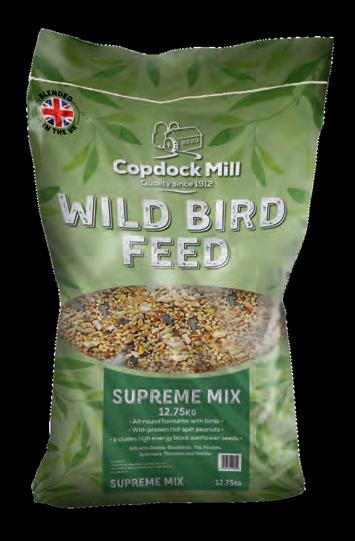









07
08
10
13
15
21
26
Christmas in the Garden Centre
Garden Centre Association chief executive Peter Burks shares his thoughts on the importance of the festive season to business in the garden retail sector.
Hard landscaping sales made easy
GIMA members share tips on sales in the decorative aggregates and garden lighting sectors.
Working against complacency
Andrew Burton of Pleydell Smithyman reflects on recent the fantastic season in garden centres, but warns about complacency
Navigating crisis communications
Fay Clarkson, operations and account director at specialist home and garden PR agency Honest Communications, digs into why having a crisis communications plan isn’t just a “nice-to-have” – it’s essential.
An interview with Ross McEwan
Newly-promoted to retail operations director at Squire’s Garden Centres, Ross McEwan talks us through his plans and views on the industry.
Highlights from the HTA National Plant Show
Regular GCR contributor Cassie King reviews the HTA National Plant Show, including the new releases we may see in garden centres soon.
Being WaterWise
Garden Centre Retail speaks with Jo Osborn of water conservation campaigning organisation Waterwise about how garden centres can lead the way in sustainable water use.
31 Hydrangeas
We take a look at a variety of Hydrangea species that garden centres can showcase.

08

21

26
34 Pet products
A round up of the latest products in the pet category.

31














Garden Centre Association chief executive Peter Burks shares his thoughts on the importance of the festive season to business in the garden retail sector.
The spring peak season is now well behind us, and the lovely sunshine that contributed to its success is now certainly causing a more significant drop-off in sales than we would hope.
A nice steady June and July would be ideal to bed in those early gains. As we sit here in the current sweltering heat wave, it’s hard to get your head around thinking about the next big peak, that being Christmas.
Christmas sales now represent as much as 10% of a garden centres total sales, according to our Garden Centre Association Barometer of Trade. The stock is only out for four months at the most and most of the sales come in the seven weeks of November and December, with the sales in these two months almost the same.
October sales are just a third of November’s, giving you an idea of the ramp-up in sales once we pass the October school halfterm, a key calendar date to be fully set up for.
Garden centres began their love affair with Christmas, as it was a great product range to fill what used to be one of the quietest periods of the year. Initially, there were those pioneers who embraced it and, of course those who thought ‘this is not gardening, we will steer clear’.
What has been very interesting is the further expansion of products and attractions on offer during this time to keep attracting people in, and keep them on site for longer, or even at different times of the day.
Garden centres are fortunate to have large, dry, warm undercover areas that the high street either no longer has or can’t afford to fill for the rest of the year, if it did decide to take Christmas on.
Also, the seasonal nature of gardening and outdoor lifestyle products means creating space within your centre is relatively easy. Dramatic visual merchandising provides eye-catching, dynamic displays that both adults and children love. A real feast for all our senses, with colour, sound, movement and fragrance all important. The best displays also add other features such as water, train sets and fun areas with distorting mirrors and dressing-up ideas.
Our GCA Christmas Competition is judged in November every year so that the winners can use the accolade in their PR and marketing over the last few key weeks of sales.
In 2024, our winners were Garsons in Esher, Castle Gardens in Sherborne and Pugh’s Wenvoe. If you need some inspiration for your displays, head to one or all of these early in your set-up.
Most of the year we tend to be visited by those aged 45+, but the good news is that at Christmas time, this changes completely. The Christmas displays bring young couples, younger families and children with anyone who will bring them. This brings significant additional benefits to other areas of the business, with catering and gifts leading the way.
Restaurants are the second biggest sales category in both November and December,
with gift sales being more than double the average month in both key months. Gift sales also contribute more than 10% of total garden centre sales in the year.
Finally, there are the other attractions that Christmas, and winter, can bring and the opportunities are endless for garden centres. From ice rinks, circuses, Christmas grottoes, light festivals, Christmas lunches, wreath making classes to much more, the list just goes on.
These also almost always draw in customers you do not see during the rest of the year. If you can impress them with what you do at Christmas time, you might get them to call back in at other times of the year too.
About Peter Burks
Peter Burks, CEO of the Garden Centre Association, is a fully-Trained horticulturalist and has worked in directorial and management roles for over 40 years. Peter helped set up and run the multi-award-winning Sanders Garden World in Somerset. He also became regional manager of the South West for Wyevale Garden Centres, and general manager for Trelawney’s in Cornwall, and managing Fermoy’s Garden Centre in Devon. gca.org.uk


As customers snap up landscaping lines and outdoor lighting to transform their gardens, GIMA members offer a look at the latest products creating opportunities for retailers in these categories, from showstopping decorative aggregates to stylish solar lights.
Helping gardeners create unique outdoor spaces, Deco-Pak has placed a strong focus on innovation over the past year. In a category first, the landscape specialist’s new Lemon-Scented Shell Chippings are an exclusive aggregate that combines natural scent with striking visual texture. The subtle lemon fragrance makes it ideal for familyfriendly spaces, while its design appeal speaks to consumers looking to personalise patios, pots and pathways.
Meanwhile, Deco-Pak is also helping garden retailers to tap into the premium end of the landscaping market with its latest Signature Collection. At the heart of the collection is Midnight Ice, a blend of charcoal and grey marble chippings that shimmer when wet and glow when dry. The premium gravel delivers instant impact and sophistication to borders, paths and feature zones, but what truly sets Midnight Ice apart is its ability to combine stunning aesthetics with environmental responsibility. The chippings are washed using recycled grey water and packed in the Signature Collection’s recyclable bags which contain up to 50% post-consumer plastic; reinforcing Deco-Pak’s mission to make luxury more sustainable.
Altico’s Premium Decorative Aggregates bring both style and substance to outdoor

spaces—allowing gardeners to enhance pathways, borders, and features with highquality, beautifully finished materials. From striking polished pebbles to timeless natural stone chippings, this range provides premium appeal that encourages shoppers to invest in long-lasting, high-value landscaping solutions. Boosting basket spend, this premium offering inspires creative garden design and gives garden enthusiasts the finishing touch their spaces deserve. With merchandising stands and impactful point of sale available, this is the solution to help turn everyday gardens into stunning landscapes.
Responding to 2025’s top garden trends, which have seen high demand for sustainable, low-maintenance gardening, Meadow View Stone is leading the way with ECO Sparkle
20mm. This best-selling aggregate blends recycled China Clay by-products with white chippings, offering striking visual appeal and strong eco-credentials. Ideal for gravel gardens, it supports biodiversity, water retention and drainage. As homeowners prioritise climateconscious choices, ECO Sparkle empowers garden centres with a product that meets demand for beauty, sustainability, and innovation. Launched at Glee 2024, ECO Sparkle is already a top 20 best-seller, with a re-ordering rate of 45%.

When it comes to giving the garden a facelift, landscaping lines aren’t always an easy ‘pickup’ due to their bulk and weight. Customers are unlikely to decide on a whim to grab some new edging or stepping stones – unless, of course, you’re stocking Primeur’s garden collection. The lightweight, yet durable,

recycled material used in Primeur’s EZ Border and Eco Way garden ranges opens up fantastic opportunities for impulse purchases in landscaping categories. The eco-credentials of these ranges also make them a clear winner in the sustainability stakes. Ideal for finishing garden borders and pathways, the EZ Border is quick and easy to install, with its flexibility enabling users to create curved shapes effortlessly. Made from recycled rubber tyres, these hardwearing edging products –available in a variety of styles – mimic a stone

finish but are a fraction of the weight, meaning customers won’t have to plan before making a purchase. It’s the same story with Primeur’s Eco Way stepping stones, which are also made from recycled tyres and have been engineered for all-season durability. They are virtually indestructible and, unlike traditional materials used for garden products, will not crack, fade, stain or rot.

The soft, tactile nature of recycled rubber makes these products perfect for gardens used by children or those prone to slips, trips or falls. Not all customers currently have the budget for a complete revamp, but retailers can still provide options to help consumers refresh their landscaping look, including bringing paving and decorative aggregates back to their best with a decent cleaning product.
Block Blitz® Original Eco Cleaner is perfect for maintaining block paving, gravel, and decorative aggregate surfaces with ease. Made from a powerful mineral and plant-based formula, it’s designed as a treatment system that gradually cleans and protects outdoor surfaces. It’s 100% biodegradable, non-abrasive, and contains no bleach, acids, or biocides. With a self-cleaning action, no jet washing

or scrubbing is required; users just apply the cleaner and leave. Dirt, grime, and organic debris are washed away naturally by rainfall. Quick and easy to use with no measuring needed, Block Blitz® is a smart, eco-friendly solution for effortless outdoor surface care. Also makes for a perfect add-on for any customers investing in new landscaping, helping them to protect and maintain their space over the years.
4lite has expanded its award-winning Antheia solar lighting range with the addition of three lanterns, providing a perfect offering for garden retailers. Requiring no wiring or running costs, the Antheia Tabletop lantern is lightweight and portable, making it ideal for outdoor dining and entertaining. The 50cm, Tall lantern is great for illuminating patios and decking and features PIR motion detection, as does the Wall lantern for enhanced security.
All Antheia lanterns are crafted from robust die-cast aluminium, are IP54-rated for outdoor use, and come with a four year warranty for added peace of mind.
Meanwhile, the Greenkey Table Top Solar Light Range offers a stylish, energy-efficient


lighting solution for outdoor spaces. Available in two sizes (small and large) and two shapes (cylinder and square), these lights provide a sophisticated-looking solar solution with the textured natural brown finish. Designed for convenience, they require no wiring, harnessing sunlight through high-powered solar technology and lithium-ion rechargeable batteries. The impressive LED system delivers a warm glow, bringing ambience to summer evenings in the garden. Whether for patios, lighting up paths, or outdoor dining, the Greenkey range blends elegance with practicality, offering a sustainable and effortless way to illuminate outdoor areas.
About GIMA GIMA is a membership organisation of around 170 companies representing the majority share of suppliers and manufacturers operating within the UK gardening industry, together with an estimated £4billion in annual trade.

GIMA’s goal is to promote the commercial, trading and industrial interests of its UK and EU-based members supplying the UK garden retail industry. Run by a small team of dedicated professionals, and governed by a council of members, GIMA is funded by membership subscriptions and services. The range of services and support provided for members is extensive, offering something for all members, regardless of their size or heritage. gima.org.uk

Andrew Burton of Pleydell Smithyman reflects on recent the fantastic season in garden centres, but warns about complacency
If you’re in the garden centre world, 2025 has been one to celebrate. In a word — Sunny.
Yes, there were some weather hiccups along the way (weather over Easter week and May bank holiday weekends spring to mind), but overall, it’s been a fantastic year for our sector.
The latest HTA Market Report (June 2025) paints a clear picture: by the end of May, garden centre sales were up 12% compared to both 2024 and 2023. Every category saw impressive growth, at least 7% ahead of 2024 figures and 10% above 2023 levels. After a warm, dry spring, business is in full bloom.
This momentum isn’t entirely new. Many centres have been riding a wave of strong trade since 2020, when lockdown life sparked
renewed enthusiasm for home improvement and gardening. From transforming home offices to creating garden sanctuaries, consumer interest has stayed strong and with the addition of things such as catering expansions, retail food, improved retailing and process management that we have seen

in garden centres, the sector continues to thrive. But here’s the catch — success can breed complacency.
It’s tempting to take our foot off the pedal when sales are strong, footfall is steady, and customers seem happy. But garden retail is dynamic. If anything, it’s one of the most changeable and exciting sectors I’ve worked in. Weather patterns shift dramatically, customer expectations evolve, the economy keeps us guessing, and competitors sharpen their strategies.
I live by the Kaizen principle of continuous improvement. And the reality is simple: garden centres that coast along during the good times often stumble when the market gets tough, the weather turns, or consumer habits shift.
Everyone is prone to this, and even topperforming garden centres can fall into the trap, but common signs include:
• Product ranges and displays feeling stale or uninspiring
• O verlooked cafés, restaurants, or leisure spaces
• Gaps in staff training and expertise
• Weak digital presence — outdated websites, dormant social media
• Marketing that ignores new gardeners or emerging trends
During booming periods, these things can fly under the radar. But when competition heats up or customers expect more, they become glaring weaknesses. So how does a business react to this?
History shows: the best time to future-proof your business is when cash flow is strong. For garden centres, that means:
Today’s consumers want more than products — they want experiences. That’s why leading centres are levelling up with vibrant cafés, play areas, inspiring retail spaces, hands-on workshops, and seasonal events that turn a simple visit into a memorable day out.
Online engagement is booming. From e-commerce to social media, the most successful centres are building intuitive websites and cultivating active, loyal digital communities.
Knowledgeable, passionate teams are your secret weapon. Investing in horticultural training, product knowledge, and service skills keeps your team ahead — and keeps customers coming back.
Eco-conscious gardening is here to stay. Strong sales periods are the ideal time to expand your sustainable offerings, experiment with biodiversity-friendly products, and trial new ranges — from peat-free compost to pollinator-friendly plants.
The garden centre sector lives and dies by the weather. We’ve all seen how a bad spring or extreme drought can hit hard. Using good trade periods to invest in resilience — covered plant canopies, indoor retail space, diverse product lines — reduces your vulnerability to unpredictable seasons.
The most successful garden centre businesses I work with share one thing in common: they do not treat good trade as the finish line, but as the launchpad for future growth. They stay curious, seek out new opportunities, listen closely to evolving customer needs, and stay agile enough to pivot when conditions change. Because here’s the hard truth — success today doesn’t guarantee success tomorrow. Those who sit back are often the first to fall when the market shifts.
Summarising this all, let’s celebrate the sunshine and the sales — but keep building, keep evolving, and never lose that hunger for what’s next.

About Andrew Burton
Andrew works for Pleydell Smithyman as an associate director, focusing on garden centre and farm shop advice, with an overarching aim of business strategy and development. He provides site development, and commercial and operational support. He sits on the Farm Retail Association Council, and previously on the Garden Centre Association Board. andrewb@pleydellsmithyman.co.uk

Exhibiting at and


Fay Clarkson, operations and account director at specialist home and garden PR agency Honest Communications, digs into why having a crisis communications plan isn’t just a “nice-to-have” – it’s essential.
In an industry rooted in expertise and innovation, horticulture is far more than a calming escape or leisurely pastime – it’s serious business. From largescale nurseries and garden centre chains to specialist growers and product manufacturers, our sector supports a complex web of supply chains, customer relationships, and brand reputations. So, when something goes wrong, the impact can be far-reaching. A product recall, a staff incident, or negative social media attention – no business is immune. That’s why having a clear, robust crisis communications strategy in place is essential, not optional.
What do we mean by a crisis?
A crisis is any event that threatens to harm people, property, operations, or your reputation. For garden centres and horticulture brands, it could be anything from a customer injury onsite or a data breach in your loyalty scheme to a product recall or supply chain delays.
Handled well, these incidents might just ruffle a few petals. But handled badly? You could be dealing with long-lasting damage.
What is crisis comms, and why does it matter?
Crisis communications is the strategy of managing your messaging and response when something goes wrong. It’s about telling the right people, the right thing, at the right time - and doing it in a way that builds trust rather than breaks it.
When a crisis hits, being silent, vague, or inconsistent with messaging is the worst thing a brand can do. People (including the press) will fill the void with their own versions of events. But a good crisis comms plan ensures you’re in control of the narrative, offering clarity and confidence even when things go wrong.
Why every brand needs a crisis comms plan
Think of it like a garden: the best results come with a little planning and thinking ahead.
A crisis comms plan sets out who says what, to whom, and how, before you’re kneedeep in damage control. It helps avoid panic and paralysis, and means your team can focus on delivering reassurance, not scrambling for a statement.
It’ll help speed up your response, keep your messaging consistent, minimise confusion, protect your reputation, and reassure staff, customers, and the wider community.
The eight pillars of a good crisis comms plan
1. Act quickly and transparently:
Don’t go into flight, fight, or freeze mode. Stay calm, and share what you know honestly, even if it’s not everything. Delays or deflections erode trust fast.
2. Have a clear chain of command: Know in advance who’s taking the leadideally a trained spokesperson - and what the internal sign-off process is. There’s no room for crossed wires or “who approved this?” panics.
3. Stick to the facts:
Avoid guesswork or speculation. Be upfront about what’s known, what isn’t, and what’s being done.
4. Prioritise key stakeholders: Start with those directly affected - customers, staff, and suppliers - before going public. They should never hear bad news from the media first.
5. Use multiple channels:
From email to social, website banners to press releases, don’t put all your messages in one basket. Reach people where they are and ensure all platforms are covered.
6. Be empathetic and human:
Tone matters, so stay true to your brand voice while showing genuine concern and care. It’s not just what you say, it’s how you say it.
7. Monitor and adapt:
Track how your messages are landing. Tweak as needed and stay alert to misinformation sprouting up.
8. Conduct a post-crisis debrief:
Once the dust settles, review what worked and what didn’t. Update your plan and be ready for next time (hopefully far in the future!).
A well-prepared crisis comms plan helps protect more than just your bottom line - it safeguards your people, your customers, and the hard-earned trust you’ve nurtured over the years.
So, whether you’re starting from scratch or dusting off a forgotten plan, make it a priority this season. And if you’d like a helping hand, give us a shout. At Honest Communications, we know our delphiniums from our data breaches — and we’re here to help with PR strategy, social media, influencer marketing, copywriting, and everything in between.

Fay Clarkson is operations and account director at Honest Communications, which is the chosen PR and social media agency of many leading garden brands, including: elho, Hillier, Town & Country, WOLF Garten, and Wilkinson Sword.

Ensure your garden centre kitchen is equipped to handle seasonal demands. Assess your equipment now to avoid breakdowns, maximise profit and increase customer satisfaction.
Our unique, all-inclusive equipment and support package
State-of-the-art appliances with nothing to pay upfront
No install fee, repair bills or call-out charges
Inclusive breakdown cover
8-working-hour response, 7 days a week
24/7 support from friendly advisors
One simple monthly payment
Parts and labour breakdown cover on existing appliances
Choice of parts &/or labour
Different levels of cover to suit your needs
5-day call-out
Annual compliance certification
24/7 support from friendly advisors
Option to buy new appliances with cover




Garden Centre Retail speaks with the new retail operations director at Squire’s Garden Centres, Ross McEwan, about his history in the sector, his outlook and his aims and goals for his new role.
Back in June this year, Squire’s announced the evolution of its senior team, with two internal promotions to the board alongside the appointment of two non-executive directors. As one of the internal changes, Ross McEwan has embarked on a new role with a business that he has been associated with since his school days.
McEwan now holds the title of retail operations director at Squire’s Garden Centres, a 17-centre strong business with stores across the south of England. Initially starting as a weekender in 1995 at Bertram’s Nursery (The Willows Garden Centre in Windsor), McEwan’s journey with Squire’s started when the business acquired the site in 1996.
Following on from school, McEwan studied at Writtle College in Essex, where he obtained his degree in horticulture, and apart from two ‘holidays’ away from Squire’s, the first with Wyevale in the early 2000’s and the second a five-year stint with the RHS in the late 2010’s, he has spent his years in several different roles across many different sites with the
family business. Upon rejoining the business in 2020, McEwan took on a role in sustainability and some eighteen months ago became group operations manager before his promotion on board in May.
In his new role, which Squire’s says is a key step in further shaping the future of customer experience, McEwan will be a vital cog in the wheel. But what type of leader will he be? “I would like to think I’m inclusive, supportive and decisive,” he says. “I would also like to think I act as a mentor and a coach for those around me.
“I see my role as a piece of thread that ties all the various business disciplines together to try and make it cohesive and understandable for our operational teams. I will be trying to get all these different voices and streamline them into a language that is easily manageable for the teams at the sharp end of the pencil.”
This role will not come without its challenges, and according to McEwan, these types of challenges are not for the fainthearted.
He says, “As a strong horticultural business, the last two years have demonstrated that weather patterns can be not only our biggest opportunity but also our biggest risk.
“Beyond that, the news hasn’t changed. It’s the balance of ever-rising cost basis, challenging economic pressures from outside of the business which have an impact, and margin pressures. Our story is no different from any other garden centre or retail operator out there.”
It is, however, McEwan’s belief that the opportunities still outweigh the pressures. “My personal belief is that out-of-town retailing remains strong, especially with good catering. It is difficult to service year-round appeal just on plants – we must make sure we are a yearround attraction, whether this is on product portfolio, value or event led footfall drivers. “We operate our centres to be a local community support. Given the amount of new housing developments in our catchments, I see this as being ever more important - welcoming new customers, new people to our businesses.”

We have seen the diversification of garden centres over the past decade or so; how will Squire’s leverage that as an opportunity? Simply put, it’s down to their welcoming and knowledgeable staff, offering a better, localised retail experience, whilst remaining true to the Squire’s values. Says McEwan, “We have the Squire’s Purpose and Truths, which still stand well in today’s world, and we’ll continue to build on these that ultimately focus on product, people and environment.
“The cost price sensitivities, which have become more evident in the last couple of years, will remain important. Layering an experience from an array of events to a more stylistic shopping and dining experience or environment will continue to be drivers to get more cars in our car parks and arguably bums on seats in our restaurants.
“But importantly, our people are a focus for us. We pride ourselves on our teams being welcoming, knowledgeable and delivering that little bit more. It’s almost difficult to measure. We do have a responsibility to help and educate our customers, especially given all the varying climatic changes that people experience and I’m a firm believer that this is best done through people, not necessarily technology. Technology can work as a support, but people speaking to people is arguably the best educator.”
Having spent the past five years working on the sustainability goals for the business, McEwan is hoping to be able to push that a
We operate our centres to be a local community support.
little further with continued growth. Squire’s receives feedback on their actions through customer surveys, so the business is constantly looking to make improvements where possible.
“Customers now expect us to behave in a manner which constantly aims to improve our relationship with the environment,” he says.
“What I mean is that we can’t change all our fleet of diesel vehicles to electric overnight. It takes time, but we have been doing a lot, especially over the last five years. We are developing across our seven sustainability commitments, which touch each part of our business and importantly, our people, customers and local communities. We’ve been busy across all fronts, especially since emerging from the pandemic.
“We agreed that any business action or decision should be aligned to at least one of our commitments, meaning that we have a collective progression of improvement rather than just one single focus and my responsibility today is that we maintain that mantra and we continue that work path.
“So yes, my day job has grown and expanded a little bit, but the focus on the
building blocks of our initiative should remain paramount, and that’s a collective movement rather than just one person.”
In terms of the big drivers in sustainability, it falls into three categories at Squire’s. McEwan explains, “If you’re not careful, sustainability can gobble you up. What we’ve tried to do is act in a sustainable way, but also hopefully drive some business growth, because the ultimate sustainably action is that we maintain wide employment and stay in business.
Number one is our buildings and our infrastructure. We have several buildings which are operating outside of what they were originally designed to do. They weren’t designed as retail environments, which in turn can yield various inefficiencies and, in our case, challenging retail and working conditions. But energy saving measures are now a key consideration, whether that’s the smallest repair or renewal, or our major developments at Twickenham and Milford, so we want to keep investing in our business, creating better places for our people to work in and for our customers to enjoy.
“Beyond the buildings and infrastructure, there’s product. Our buying team, led by Ricky Bowness, does an amazing job working with our supply chains to source a mindboggling array of products, from ethical sourcing, reducing packaging, staying local and introducing newness. These are all things that help our customers live a more sustainable lifestyle, and sometimes our customers might not even recognise it.

“The final thing is our people. We have a core of centre-based sustainability champions who individually bring so much to the table with their dedication to be better and do better.
Environmental awareness is already in our DNA. With our champion’s help, we can work towards all our people being sustainability champions, which in turn will give a collective behavioural shift to give us a better future for our business.”
McEwan has already mentioned how technology can supplement the personal approach in a garden centre. It’s obvious that he and his team are people-centric, and technology can sometimes jeopardise that area of a business. McEwan has a unique view on how technology and people can work complementarily. “I’m all for finding the shortest possible route from A to B without shortcutting. In our business, anything we can do that alleviates an admin task and frees up time to concentrate on a customer or growth has got to be a positive.
“We’ve been disciplined in chopping out any tasks that have become outdated or unnecessary across all functions. This is with working with all the colleagues who manage their various disciplines, but they all work tirelessly and continuously to improve workflows across their various functions.
“We’ve made some headway over the recent years in IT systems, people processes, stock management, communications and compliance, but as the tech evolves and as the business evolves, we have to be open-minded to the advances in optimisation and in the consolidation of systems and processes.”
With a typical customer base for a garden retail business, Squire’s is aware that technology is not for everyone. However, the recent successful implementation of the Friends of Squire’s App, an initiative driven by group marketing manager Karen Smith, shows that these types of advancements are going to become part of everyday life in the future.
McEwan explains, “It’s new for us – it might not be necessarily new on the market,
but the ability to personalise and enhance the experience in and out of the centre, and give us that visibility and insight of those that engage with us is a bit of a game changer.
“Beyond all the marketing advantages and efficiencies that come about with operating such a scheme, we have also unearthed a
their table. I see that as a bit of a win-win for both parties.”
We agreed that any business action or decision should be aligned to at least one of our commitments.

particular business opportunity which sits within our restaurant side of the business.That is customers ordering their food and beverages via the app. This can deliver some tremendous advantages across our estate as of today.
“If we can nail that initiative and try to get more of our customer base and indeed the Friends of Squire’s users to adopt that different way of using tech, not only will it benefit them as customers because they get their food and their drinks quicker without queuing, but our kitchens and our teams can operate in a more efficient manner.
“But most importantly, we still have the touchpoint and the engagement with our people because our people deliver the food to

McEwan’s promotion to the board comes at a time of change at the top. Long-standing managing director Martin Breddy announced his departure from the business, and new MD Sam Dickson has come in to take on the role. “Sam will have her views and leadership direction along with the wider senior team,” explains McEwan. “Importantly, we continue to be a thriving fourth generation family business, now with all three living generations active in the business, and a continued focus on our core values and the future.
“We are all about our local communities and that’s something that I see myself working with the team to try and keep that traction. As I mentioned before, with all the housing developments in our localities, it’s going to become more intrinsic to our business and a big part of our belief in what we do. That will also help us with a greater understanding of the customer base and the changing needs of that customer. My role over these next five years is very much a supportive role to try and untap the potential that we discover over the coming years and months.”
Ross McEwan’s journey from weekend work to board-level leadership at Squire’s Garden Centres reflects a deep-rooted passion for horticulture and retail. His inclusive leadership style, commitment to sustainability, and focus on enhancing customer experience position him as a driving force in shaping the future of the business.
With a clear vision for integrating technology, supporting local communities, and adapting to evolving customer needs, McEwan is set to help lead Squire’s through a dynamic period of growth and transformation. His dedication to people, product, and the environment ensures that Squire’s remains a trusted yet forwardthinking name in garden retail.
26 SEPTEMBER 2025





“Business Strategy Stage” dedicated to driving business growth
Topics include
• Consumer and business trends – learning from hospitality, leisure and retail?
• Diversification dilemma / 2.0
• The Finance and Investment Sessions
• Selling sustainability – leveraging what we are famous for to drive future growth
“Operational Excellence Theatre” focused on improving performance and efficiency
Topics include
• Pricing strategies – what action can we take to drive volume and profit?
• Profiting from our “World cup” retailing opportunities
• How can sustainability help you access key business insight?
• NiCs, minimum wage increases – where are the opportunities to drive productivity in our businesses?
• Loss prevention – masterclass on minimising retail theft
NEIL GRANT, MANAGING DIRECTOR, FERNDALE GARDEN CENTRE
SAXON MOSELEY, PARTNER AND HEAD OF LEISURE & HOSPITALITY AT RSM UK
SAM BOSWORTH, OWNER, BOSWORTHS GARDEN CENTRE
AMY STUBBS, PROJECT AND DEVELOPMENT MANAGER, BRITISH GARDEN CENTRES
CORIN DENNISON, MANAGING PARTNER, INSIGHT RETAIL RISK CONSULTANCY LTD
ANDREW BURTON, ASSOCIATE DIRECTOR AT PLEYDELL SMITHYMAN











The June sun was relentless, but that didn’t stop hundreds of plant enthusiasts from flocking to NAEC Stoneleigh for the biggest HTA National Plant Show, which celebrated its 15th anniversary with its largest and most dynamic event to date. As the flagship gathering for the UK horticultural industry, the show brought together over 158 companies, showcased the latest in plant innovation, and provided a vital platform for networking, learning, and celebrating British horticulture.
This year’s show featured more than 261 exhibition stands that spanned the entire horticultural supply chain, with everything from seeds, bulbs, and garden plants to cutting-edge labelling, growing media, display benching, and horticultural machinery. The event reinforced its reputation as the one-stop destination for garden retailers, growers, and suppliers to discover new trends and solutions for the upcoming season.
The heart of the National Plant Show is undoubtedly the New Plant Awards, sponsored by the RHS and verified by Joy
of Plants, given to the most innovative and outstanding plant varieties launched in the past year. This year, there was a record number of 137 qualifying judged entries across the categories of herbaceous perennials, annuals, tender perennials & container & basket plants, flowering houseplants, foliage houseplants, cacti & succulents, trees (including conifers) and shrubs (including conifers) & climbers.
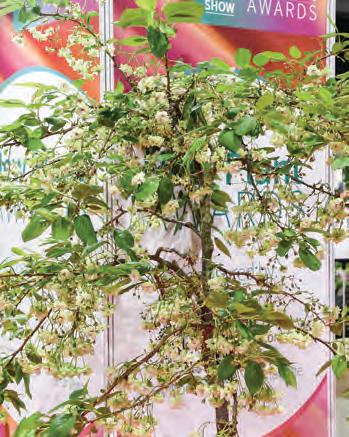
Judging was conducted by an expert panel which featured Emma Allen, RHS head of horticultural relations, Cath Quinney, Bennybeg Plant Centre, Alan Down, HTA Immediate Past President and Down to Earth, Anisa Gress, Potting Shed Press, Liam Cleary, Old Railway Line Garden Centre Pippa Greenwood, HTA’s horticulture manager and Martin Simmons, HTA member engagement manager.
The winner of the coveted Best in Show and Visitor Vote, sponsored by Floramedia, was Frank P Matthews with its Prunus Sumaura Fugenzo JAPANESE LANTERN. Winner of the Trees category, it was first found in Kobe, Japan, in 1990, and features fragrant blossoms that attract bees. What makes it unique among Sakura cherries are its stunning, densely double-frilled flowers with white, pink, and green petals that deepen with age. This medium-sized, spreading tree has bronze young leaves that mature to green and offer great autumn colour and will thrive across UK gardens.

Annuals, Tender Perennials: Beekenkamp Plants - LaBella Dahlia Grande Chocolate Rose: A stunning new dark-leafed dahlia series that’s as captivating as its name suggests. The deep, dark foliage of this LaBella Dahlia is reminiscent of the luxurious allure of chocolate and just like chocolate, these dahlias are impossible to resist.

Cacti & Succulents: Javado UK - Cotyledon ‘Green Footprint’: A low-maintenance, compact succulent, perfect for container growing and small spaces. Its striking green foliage, covered with fine hairs, gives it a soft, velvety appearance.

Flowering Houseplants:
Profitplant BV - Cyclamen Persicum Super Serie Dragon Deep Blue: A breakthrough in cyclamen breeding, the first F1 cyclamen with blue flowers. This innovation is available in two striking colours, blue and deep blue, presented together as the blue collection.

Foliage Houseplants:
Javado UK - Calathea ‘velvet glory’: A unique combination of wavy edges and plush-textured leaves makes it a visually interesting choice of houseplant for most spaces.

Herbaceous Perennials: Darby Nursery Stock Ltd & Fairweathers - Hosta ‘Silly String’: The result of an extensive Hosta breeding programme by Hans Hansen of Walters Gardens, which began in 1993. ‘Silly String’ lives up to its name with distinctive, narrow blue emergent foliage, wiggly with attractive ruffled margins. It produces pale purple flowers on tall stems that contrast beautifully with the foliage when they bloom in mid to late summer.

Shrubs (including Conifers): The Bransford
Webbs Plant Company & Darby Nurseries - Hydrangea Zeta Noir: Stood out with its exceptionally dark foliage and bright flower contrast. Its compact yet strong structure ensures lasting ornamental value, even under harsh conditions.
Javado launched a remarkable 28 new plants, which included houseplants, succulents, and other ornamental varieties. Among the introductions were award-winning plants such as Cotyledon ‘Green Footprint’, which won the Best Cacti and Succulents category, and Calathea ‘Velvet Glory’, which took the top prize in the Foliage Houseplants category.
New Leaf Plants launched a new clematis, Gareth’s Pride, named after the Worcestershire grower’s late production manager, Gareth Edwards. The red clematis was launched in partnership with St Richard’s Hospice with support from Hortipax, who donated the label. New Leaf is hoping to be able to donate some of the proceeds made from Gareth’s Pride to the hospice that cared for Gareth. Gareth’s Pride also won a Bronze award in the Shrubs (including Conifers) & Climbers category.
Ball made a splash at the event with exciting new plants that included Agastache mexicana ‘Summerlong Lilac’, Alstroemeria hybrida ‘Inticancha Mirabel’ and Armeria pseudarmeria ‘Dreameria Vivid Violet’. Wyevale Nurseries revealed their 2026 retailers’ catalogue, packed with Britishgrown plants, including Anisodontea ‘Carnival Lights Collection’, Dahlia ‘Omega, Exochorda racemosa ‘Blushing Pearl’, Geranium ‘Orkney Cherry’, and Geum ‘Flames of Passion’, all chosen for their unique looks and hardiness.
The “Rose of the Year 2026”, Coral Gardens, was launched at the show by Wharton’s. The rose was bred by W. Kordes & Sons of Germany, with Thomas Proll as the breeder, and Wharton’s is the UK introducer responsible for its commercial launch into the market. Euphorbia ‘Walberton’s Little Treasure’, bred in the UK by Walberton Plants and distributed by Farplants, was also launched to the trade at the show.
The award for Best Stand went to Ball, which showcased its products and brand with flair and style.
YPHA was at the Plant Show to showcase the result of its Launch Success Challenge, ‘Bountiful Pink’. The challenge saw ten delegates split into two teams to compete in creating and launching a new begonia. Over several months, they received training, mentorship, and hands-on experience, including visits to Floramedia and Beekenkamp Plants in the Netherlands. The teams learnt about marketing, plant breeding, production, and the supply chain and took part in seminars and workshops on product development,

market research, branding, photography, and communication. Each team pitched their new plant to industry professionals.
The winning team— Laura McArthur, Leif Mann, Beth Anderson, Jacob Hatch, and Molly Parkin —won with their concept for ‘Bountiful Pink.’ Bred by Beekenkamp Plants, the new plant features masses of pink flowers, a compact upright shape, and is easy to grow both indoors and outdoors. It’s suitable for borders, pots, window boxes, or as a houseplant, needing little maintenance and no staking. ‘Bountiful Pink’ will be available exclusively at selected British Garden Centres stores.

Taylors Bulbs launched “Packed with Joy” to retailers, a fresh, multi-channel campaign created to spark excitement and help garden centres connect with customers all year round. “Packed with Joy” celebrates the magic in every bulb conveying to gardeners that patience yields beautiful results. It runs yearround, highlighting the best planting times for bulbs and edibles, keeping customers coming back through every season. Taylors exhibited its bold POS materials, which retailers can use to showcase the right products at the right time and maximise seasonal sales with a consistent,
engaging message. “Packed with Joy” will also be supported online and on social media, with Taylor’s providing a full set of digital assets to download for retailers to include in their marketing.
The show also highlighted new developments in retail solutions such as labelling, growing media, display benching, and horticultural machinery, providing garden centres and growers with enhanced tools to improve efficiency and customer experience.
Bransford Webbs launched and demoed its brand new app to customers over the two days. Designed for trade customers, the app streamlines the ordering process by allowing users to browse the full range of available plants, view up-to-date images and prices, and place orders instantly from their smartphone or tablet. This new digital tool allows customers to manage orders on the go, even outside normal office hours, and offers features such as live stock availability, order tracking, and instant confirmations.
The app is available for both Apple and Android devices, as well as a desktop version for PCs, ensuring accessibility for all users and offering a new level of convenience and efficiency to their customers.
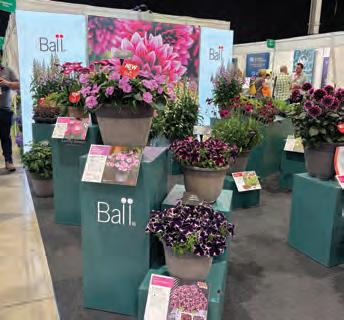
This year’s HTA National Plant Show proved to be the biggest and best yet, with 158 exhibitors taking a total of 261 stands, delivering a vibrant mix of established names and fresh faces.
New exhibitors for the 2025 event included Tendercare, Lantra, Insight Retail Risk, Woodlodge, Grazers, PondPlant UK, Appetite Me, Troo, RocketGro, Macpac, Kolff Plants, White Logistics, Floralinc, and Volta Eco. Their participation brought a wealth of new products, services, and perspectives to the show, further enriching the experience for visitors and buyers.
The Plant Show featured key debates around the impact of post-Brexit policy and trade on British horticulture. The session titled “EU Reset: What to Expect” explored how new developments and trade opportunities will shape the industry’s future.
Crop protection was another major topic, with a focus on the balance between voluntary contributions and emerging initiatives to safeguard ornamental plants. Attendees also engaged in conversations about sustainable nursery management, sharing practical insights to improve efficiency and environmental responsibility in plant production.
Sustainability was a headline theme, particularly the challenge of achieving net zero in garden centres. Panel sessions and presentations highlighted strategies for reducing carbon footprints and adopting greener practices. Plant biosecurity was also a critical area of discussion, emphasising the importance of managing health risks and strengthening protective measures across the sector.
The inclusion of networking events for groups like Women in Horticulture and the Young People in Horticulture Association (YPHA) further highlighted the industry’s commitment to inclusivity and nurturing the next generation of horticultural talent for the years ahead.

Each garden centre we build is unique, just like the people behind it.
Each garden centre we build is unique, just like the people behind it.
Each garden centre we build is unique, just like the people behind it.
Each garden centre we build is unique, just like the people behind it.
Curious to learn more about our approach and services? Come and talk to us at Glee, stand 11B79.
Curious to learn more about our approach and services? Come and talk to us at Glee, stand 11B79.
Curious to learn more about our approach and services? Come and talk to us at Glee, stand 11B79.
Curious to learn more about our approach and services? Come and talk to us at Glee, stand 11B79.
Visit us at www.rabensteiner.eu/en or scan the QR code to explore our latest newsletter:
Visit us at www.rabensteiner.eu/en or scan the QR code to explore our latest newsletter:
Visit us at www.rabensteiner.eu/en or scan the QR code to explore our latest newsletter:
Visit us at www.rabensteiner.eu/en or scan the QR code to explore our latest newsletter:





Founded as a family business in South Tyrol, Italy, Rabensteiner is now one of Europe’s leading manufacturers of innovative garden centre structures. With over four decades of experience, the company has built a strong reputation for delivering durable, visually striking and commercially effective solutions.
No two garden centres are the same. That’s why every project is individually designed and developed in close collaboration with each client to reflect their brand identity, operational needs, and long-term goals.
The Rabensteiner portfolio ranges from compact retail concepts to large-scale complexes and strategic upgrades.

The company also has strong expertise in eyecatching façades for garden centres, stylish cafés and restaurants in glasshouse settings, and partial refurbishments to enhance existing structures. All designed to elevate the customer experience and boost commercial performance.
Modern water management systems and the smart integration of solar energy are standard features in many of our builds. These not only reduce long-term operational costs but also support environmentally responsible business practice without compromising on aesthetics.
Rabensteiner combines functionality and design excellence to create inspiring spaces that grow alongside your business.
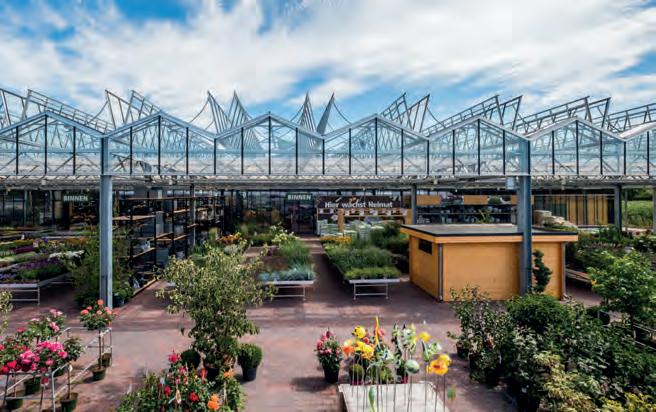

Garden Centre Retail speaks with Jo Osborn of water conservation campaigning organisation Waterwise about how garden centres can lead the way in sustainable water use.
Water is one of our most precious resources—and one that is increasingly under pressure. With climate change intensifying drought conditions, water bills rising, and consumers demanding more sustainable practices, garden centres are uniquely positioned to make a difference. These vibrant hubs of horticulture and hospitality rely heavily on water, yet many are only just beginning to understand how to use it wisely.
Enter Waterwise, the UK’s leading authority on water efficiency. We spoke with Jo Osborn, Head of Policy and Research, to explore how garden centres can reduce water waste, improve efficiency, and future-proof their businesses—without compromising on quality or customer experience.
Water efficiency is no longer just a nice-tohave—it’s a business imperative. “Many garden centres don’t realise how much water they’re using or where it’s going,” says Jo. “And that’s a missed opportunity, both environmentally and economically.”
From an environmental perspective, reducing water use helps conserve local water supplies and reduces the energy needed to treat and pump water. Economically, it can lead to significant cost savings—especially as water prices continue to rise. There’s also a reputational benefit: customers increasingly expect businesses to demonstrate sustainability, and water efficiency is a visible, impactful way to do so.
Regulatory pressures are mounting. “We’re seeing more interest from government with targets to reduce non-household water use now in place and in mandatory water efficiency labelling coming soon and tighter controls,” Jo notes. “Garden centres that act now will be ahead of the curve.”
The first step to saving water is understanding how it’s being used. Yet, according to Jo, “About 85% of garden centres don’t measure their horticultural and non-horticultural water use separately.” This makes it difficult to identify where waste is occurring—whether it’s in plant irrigation or the café kitchen.
Jo recommends starting with your water retailer. “Businesses can choose their water retailer, and some offer much better data services than others. It’s worth shopping around to find one that can help you track and understand your usage.”
Smart meters are becoming more widely available and can provide real-time insights into water consumption. These tools can help identify leaks—such as the surprisingly common issue of “leaky loos”, which can waste up to 400 litres of water per day.
One of the biggest challenges for garden centres is balancing water conservation with maintaining healthy, attractive plants. Jo highlights the inefficiencies of overhead sprinklers: “They’re easy and save staff time, but a lot of water just falls between the pots.”
Instead, she recommends more targeted approaches like hand watering or watering into trays, which reduce evaporation and ensure water reaches the roots. “It’sHand watering is more labour-intensive, but much more efficient.”
Drip irrigation systems are another effective solution. Used in around 50% of garden centres, they deliver water directly to the plant’s root zone, but are only really useful for the big
plant specimens. Capillary watering systems, which only replace the water a plant has used, are also worth considering—especially when building or renovating a centre.
Shade structures can also play a role. “They protect plants from sun damage and reduce evaporation, which means less watering is needed,” Jo explains.
Rainwater harvesting is one of the most promising strategies for garden centres.
“There’s huge potential here,” says Jo. “Many centres have large roof spaces and car parks— perfect for collecting rainwater.”
Waterwise collaborates with companies like Stormsaver to design bespoke systems, ranging from basic guttering and tanks to more advanced filtration and monitoring setups.
“The technology has moved on,” Jo notes.
“And with water costs rising, the return on investment is becoming more compelling.”
Yet many centres still lack adequate water storage. “Some have less than five days’ worth of water stored,” Jo warns. “That’s a real risk in dry periods. Investing in rainwater harvesting isn’t just about saving money—it’s about resilience.”
Waterwise also offers a helpful “mythbusting” guide on rainwater harvesting, available on their website.


Many garden centres don’t realise how much water they’re using, or where it’s going


Garden centre cafés and kitchens are another area where water savings can be made.
Jo points to simple fixes like checking for leaks and installing efficient dishwashers.
“It’s the same advice we’d give for homes—just scaled up.”
A major development on the horizon is the UK’s upcoming mandatory water efficiency label for appliances. “It’ll make it much easier for businesses to choose waterefficient products,” Jo says. “And it’ll push manufacturers to innovate.”
Food waste is another hidden water cost.
“Every uneaten meal represents wasted water,” Jo explains. “Better menu planning and portion control can make a big difference.”
For garden centres looking to get started, Jo offers a range of practical, low-cost strategies:
1.Fix leaks:
Especially in toilets, taps, and outdoor hoses.
2.Train staff:
Waterwise’s Water Literacy programme is currently offering a free trial and helps staff understand water issues and solutions.
3.Use signage:
Posters and point-of-sale materials can educate customers and reinforce your sustainability message.
4.Promote water butts:
“They’re flying off the shelves in dry weather,” Jo says. “Why not offer DIY guides or QR codes linking to how-to videos?”
5.Improve soil health:
Healthy soil retains water better.
“It’s nature’s sponge,” Jo says. “And the right soil for the right plant makes a big difference.”
Garden centres have a unique opportunity to influence public behaviour. “You’re a trusted voice,” Jo says. “People come to you for advice. That’s powerful.”
She encourages centres to share their own water-saving efforts—especially if they’ve installed rainwater harvesting systems.


“It shows leadership and inspires customers to do the same at home.”
Interactive displays, staff demos, and digital content like QR-linked videos can all enhance the customer experience while promoting sustainability. “It’s about making water conservation part of the story you tell,” Jo explains.
Water is essential to every aspect of a garden centre’s operation—from the plants on display to the meals served in the café. But it’s also a resource under threat. By acting now, garden centres can reduce costs, build resilience, and show leadership on one of the defining environmental issues of our time.
Jo’s message is clear: “Start by auditing your water use. Talk to your water retailer. Explore funding and support. And engage with Waterwise—we’re here to help.”

Hydrangeas have long been a staple in British gardens, and in 2025, they remain one of the most commercially valuable and visually impactful plants for garden centres to stock. Their broad appeal—ranging from traditional cottage garden lovers to modern landscapers—makes them a reliable seller across a wide customer base. With their bold blooms, long flowering season, and increasing variety of colours and forms, hydrangeas offer both aesthetic and economic value.
According to the 2024 State of the Hydrangea Market report, hydrangeas continue to rank among the top-selling flowering shrubs in the UK and Europe, with strong demand from both retail and landscape sectors. Despite a challenging start to the year for outdoor plant sales due to poor weather, hydrangeas have held their ground thanks to their versatility and consumer recognition. Their popularity is also driven by the rise in smaller garden spaces and container gardening, where compact varieties thrive.
Hydrangeas are easy to merchandise, offering instant visual impact in displays and
strong seasonal appeal from late spring through autumn. They also lend themselves well to upselling—customers often purchase multiple plants to create mass displays or to experiment with different colours and types. With proper care advice, they offer high customer satisfaction and repeat business.
For garden centres, stocking a curated range of hydrangeas—covering mopheads, lacecaps, paniculatas, and dwarf varieties— can boost both footfall and revenue. In the following section, we’ll explore seven of the best hydrangeas to sell in the UK, including their growth habits, form, and ideal growing conditions.
Hydrangea macrophylla

‘Endless Summer’ is a game-changer in the hydrangea world. Unlike traditional mophead hydrangeas that only flower on old wood, this variety blooms on both old and new growth, ensuring a reliable and extended flowering season from late spring to autumn. It forms a compact, rounded shrub reaching about 1-1.5m in height and width, making it ideal for borders, containers, or as a feature plant.
The large, rounded flower heads can be pink or blue depending on soil pH—acidic soils produce blue blooms, while alkaline soils yield pink. This colour-changing trait is a great talking point for customers and encourages repeat visits for soil conditioners or pH kits.
‘ Endless Summer’ prefers moist, welldrained soil and thrives in part shade, though it can tolerate more sun with adequate watering. It’s hardy and resilient, making it suitable for most of the UK gardens.
This is an easy sell to both new and experienced gardeners. Its long flowering period, colour versatility, and forgiving nature make it a customer favourite. It’s also a great candidate for gift purchases due to its lush appearance and name appeal.


Hydrangea paniculata ‘Limelight’
‘Limelight’ is a striking panicle hydrangea known for its bold, cone-shaped flower heads that start lime green and gradually turn creamy white, then blush pink as the season progresses. It grows upright and bushy, reaching 2-2.5m tall, making it perfect for back-of-border planting or as a statement shrub.
This variety is incredibly hardy and thrives in full sun to partial shade. Unlike mophead hydrangeas, ‘limelight ’ is droughttolerant once established and flowers on new wood, meaning it can be pruned hard in early spring without sacrificing blooms.
Its strong stems hold the large flower heads upright, even in rain, and the blooms are excellent for cutting or drying. The changing colours throughout the season provide long-lasting interest, making it a favourite for landscapers and garden designers.
‘Limelight’ is a premium shrub that offers high visual impact and strong customer satisfaction. It’s ideal for customers looking for a low-maintenance, high-reward plant that performs reliably year after year.

‘Annabelle’ is a showstopper known for its enormous, snowball-like white flower heads that can reach up to 25cm across. This deciduous shrub grows to about 1.2-1.5m tall and wide, forming a rounded, bushy shape that looks stunning in mass plantings or as a focal point in borders.
It flowers on new wood, which means it can be pruned back hard in late winter or early spring without affecting its bloom. This trait makes it very reliable and easy to maintain. ‘Annabelle’ prefers moist, rich soil and partial shade, though it can tolerate more sun with adequate watering.
Its elegant blooms appear from June to September and are excellent for cutting or drying. The plant’s strong stems have been improved in newer cultivars to better support the heavy flower heads, though some staking may still be needed in exposed sites.
‘Annabelle’ is a premium hydrangea that appeals to customers looking for dramatic, classic beauty. It’s especially popular in traditional and woodland-style gardens and pairs well with ferns, hostas, and shade-loving perennials.

‘Zorro’ is a striking lacecap hydrangea that stands out for its vivid flower colours and dramatic black stems. It grows to about 1-1.2m tall and wide, forming a neat, upright shrub that’s perfect for borders, mixed beds, or containers.
The lacecap flowers feature a central cluster of fertile blue or pink florets surrounded by larger sterile florets. The flower colour depends on soil pH—acidic soils produce blue, while alkaline soils yield pink. The dark stems provide a bold contrast to the delicate blooms, adding year-round interest even when the plant is not in flower.
‘Zorro’ prefers moist, well-drained soil and partial shade, though it can tolerate more sun in cooler areas. It flowers on old wood, so pruning should be minimal—just remove dead or weak stems after flowering.
This variety is ideal for customers looking for something a little different. Its modern look and strong visual contrast make it a favourite in contemporary garden designs. It’s also a good conversation starter and a great way to introduce customers to the lacecap form of hydrangeas.

‘Little Lime’ is a compact version of the popular ‘Limelight’, offering the same stunning lime-to-pink flower transition in a smaller, more manageable size. It grows to about 1-1.2m tall and wide, making it ideal for small gardens, patios, and container displays.
This panicle hydrangea produces coneshaped flower heads that start a fresh lime green in midsummer, gradually turning creamy white and then soft pink as autumn approaches. It flowers on new wood, so it can be pruned back in early spring to maintain shape and encourage strong blooming.
‘Little Lime’ thrives in full sun to part shade and prefers well-drained soil. It’s drought-tolerant once established and very hardy, making it a low-maintenance option for a wide range of garden settings.
‘Little Lime’ is a versatile and high-impact shrub that appeals to urban gardeners, balcony growers, and those with limited space. It’s also a great upsell for customers who love ‘Limelight’ but need a smaller plant. Its long flowering season and changing colours make it a reliable favourite.

‘Bluebird’ is a refined and elegant lacecap hydrangea with a graceful, rounded habit and delicate blue flowers. It grows to about 1-1.5m tall and wide, making it suitable for borders, woodland gardens, or shaded areas.
The lacecap blooms feature a central cluster of deep blue fertile flowers surrounded by pale blue or pink sterile florets, depending on soil pH. The foliage often takes on red or bronze tints in autumn, adding seasonal interest.
This variety prefers moist, acidic soil and partial shade. It’s more tolerant of cold than some macrophylla types and benefits from a sheltered position. Pruning should be minimal—just remove dead or damaged stems after flowering.
‘Bluebird’ is ideal for customers looking for a more naturalistic or woodland-style plant. Its subtle beauty and pollinator-friendly flowers make it a great choice for wildlife gardens. It’s also a good educational plant for explaining the difference between mophead and lacecap forms.


‘Miss Saori’ is a standout variety that combines compact growth with exquisite double blooms. It grows to about 1 metre tall and wide, making it perfect for containers, small gardens, or front-of-border planting.
The mophead flowers are made up of double white florets edged in deep pink, creating a striking two-tone effect. The blooms appear from late spring to early autumn and hold their colour well, even in full sun. The foliage also turns a rich burgundy in autumn, adding extra seasonal appeal.
‘Miss Saori’ prefers moist, well-drained soil and partial shade, though it can tolerate more sun with regular watering. It flowers on old wood, so pruning should be limited to deadheading and removing weak stems.
This variety won the RHS Chelsea Flower Show Plant of the Year in 2014 and continues to be a top seller for its unique appearance and compact size. It’s ideal for premium displays and gift purchases, especially in spring and early summer.
‘Miss Saori’ is a high-value plant that appeals to design-conscious customers and collectors. Its elegant form and long-lasting blooms make it a reliable favourite for both impulse buys and planned purchases.


DogDoov Limited
DogDoov is a new and innovative dog bed. Sold as a cover and internal net, the customer utilises old bedding and clothing from home to fill the bed themselves. No more toxic foam fillers! Customers will have the satisfaction of upcycling their old linens to make a comfortable dog bed whilst helping to save the planet.
RRP: £39.99 dogdoov.com
Little Birdhouse: Robin & Songbird Mix
Harvest Pet Products
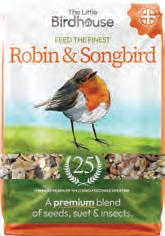
This premium bird food blend is crafted to provide essential nutrition for your garden’s favourite visitors –Robins and Songbirds. Packed with a variety of delicious seeds favoured by dunnocks and chaffinches, and nutritious mealworms for robins, this mix will keep your birds happy and healthy. This special blend is designed to support birds throughout the year with high-energy suet pellets. A unique cleaning process ensures a fresh and enjoyable meal, free from dust and chaff.
RRP: £6.99 harvestpetproducts.com
The Golden Paste Co.
TurmerItch Paste is a natural coat and skin supplement for dogs and cats. Easy to use and made with high-quality ingredients. We have worked closely with experts to achieve the balance of botanicals to help those pets suffering with skin and coat conditions such as grass/environmental allergies, yeast infections, reducing itchy skin and paws, repelling fleas and maintaining healthy skin and coat.
RRP: £9.95 goldenpastecompany.co.uk


Calming Dog Shampoos, Eco Dog Towels, Multifit Dog & Cat Supplements
DotDotPet



DotDotPet’s award winning shampoos have a calming fragrance and a vegan prebiotic formulation . The Multifits, for cats and dogs are immune boosting with veterinary endorsed natural ingredients and are available in gummy and crunchy options. The Eco Dog Towels are 100% natural, biodegradable, versatile and award winning.
RRP: Shampoos £12.99, Multifits Dry £13.99 Gummy £14.99, Eco Towels £12 dotdotpet.com
HayDay
Totally nibble-icious premium, barn-dried and dust extracted hay boxes grown on the Hay Day farm in Yorkshire. The business offers four different hay types: Timothy Hay, Meadow Hay, Ryegrass Hay and Alfalfa Hay - perfect for rabbits, guinea pigs chinchillas and degus.
RRP: £19.99 hay-day.co.uk

Automatic Litter Box V3 – XXL PETLUX
The Automatic Litter Box XXL is designed for large cat breeds like Maine Coons, offering the largest eco-friendly solution on the market. With a 100-liter capacity, it’s durable, easy to clean, and 100% waterproof. Unique features include options for biodegradable or stainless steel trays, reducing waste without chemicals. Made from recyclable materials, this litter box is perfect for eco-conscious pet owners, supporting hygiene, sustainability, and convenience. Available in black and white.’
RRP: £550 petlux.nl
Breeder Celect recycled paper cat litter FibreCycle
Breeder Celect has been the go-to litter for our kittens and cats who love a clean litter tray and a greener planet. Crafted with care from 99% recycled paper, right here in the UK, our litter is as kind to your nose as it is to the Planet. Voted Your Cat Litter of the Year 2024 and Pet Product Marketing Retailer Recommended Cat Litter 2024.
RRP: 25L £17.49 breedercelectcats.co.uk


Lid-it® Bowl With Silicone Lid Pup & Kit
The perfect solution for grazers, as a portable container or for preparing meals in advance. The Lid-It Bowl is ideal for travel or as a daycare container, is easy to clean and dishwasher safe, keeps insects away and locks in food and water. The bowl is made of stainless steel and has measurement markers. How does it work? Simply press the logo to remove the air and seal the edges for an airtight lid.

RRP:Small-£14.95,Medium-£17.95 pupandkit.com
Ramble harness
Non-stop dogwear
Non-stop dogwear Ramble harness is an adjustable harness with a handle and three attachment points. This harness is especially good for puppies or for dogs with a strong build. Ramble harness is light and comfortable with clips on both sides. In addition to the D-ring on the back, it has a loop for the tracking line on the chest. On the front there is a third attachment point for mild anti-pull.
RRP: £53.99 nonstopdogwear.com








WEBV26
Webb 114mph (183 km/h)
Webb has the tools for every situation - with products available at great margins.
British brand Webb stands for quality, superior build, and simplwity of operation - all at affordable prices!
Contact us today to find out how you can become a Webb Stockist. For peace of mind, all Webb machines come with a 3-year warranty and 2-years warranty for battery and charger.

Lawn Mowers
Hedge Trimmers
Line Trimmers
Pruning Saws
Tillers
Blowers CORDLESS




26cc Petrol Blower & Vacuum Lawn

Increase your business profit margins
Various point of sale solutions
Regular special offers
Sales and marketing support
An ever-evolving range - covering petrol, electric and cordless garden machinery.
Line Trimmers
Shredder
Chainsaws
Brush
Line Trimmers

Blowers/Vacs
Hedge Trimmers
Scarifiers
Chainsaws
Cultivators & Tillers PETROL




Hedge Trimmers












